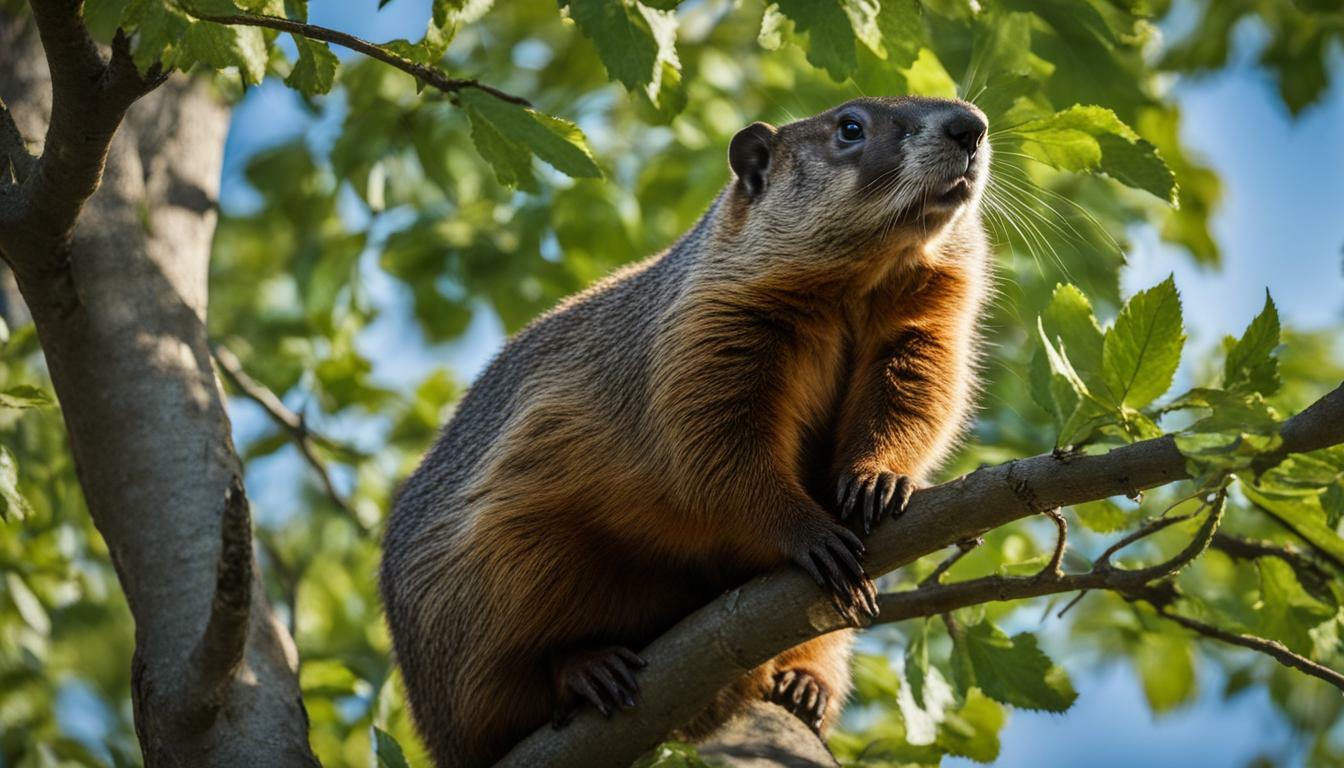Groundhogs, also known as woodchucks, are fascinating creatures that have the ability to climb trees. Despite their size, they are nimble enough to navigate tree trunks. They can climb trees to seek refuge from predators or to gain a vantage point. Groundhogs have good balance and have been observed walking on wooden fence rails. They are related to other tree-climbing critters like squirrels and chipmunks. While the exact reasons behind their tree climbing behavior remain unclear, it is believed to be a way for them to escape from danger or to explore their surroundings.
Key Takeaways:
- Groundhogs, also known as woodchucks, are capable of climbing trees despite their size.
- They may climb trees to seek refuge from predators or to gain a higher vantage point.
- Groundhogs have good balance and are often seen walking on wooden fence rails.
- They share similarities with other tree-climbing animals like squirrels and chipmunks.
- The exact reasons behind their tree climbing behavior are still unknown.
The Arboreal Behavior of Groundhogs
Despite their size, groundhogs possess a natural instinct for climbing and have been observed scaling trees. These burly creatures, also known as woodchucks, surprise us with their ability to navigate tree trunks with agility. Groundhogs may not be renowned tree climbers like squirrels or chipmunks, but their arboreal behavior is a fascinating aspect of their biology.
Groundhogs have a remarkable sense of balance, often seen walking on wooden fence rails effortlessly. Their sturdy limbs and sharp claws provide them with the necessary grip to ascend trees. While it is unclear why they climb trees, there are a few possible reasons behind this behavior.
- Seeking refuge from predators: Climbing trees offers groundhogs a safe haven away from potential threats. By retreating to the heights, they can evade ground-based predators that may pose a danger.
- Gaining a vantage point: Scaling trees allows groundhogs to get a better view of their surroundings. From an elevated position, they can survey their territory, keeping an eye out for any potential danger or sources of food.
Similarities with other tree-climbing creatures
Groundhogs share characteristics with other tree-climbing animals such as squirrels and chipmunks. While they may not possess the same level of agility and tree-dwelling lifestyle, their ability to climb trees demonstrates their adaptation to varied environments.
In conclusion, groundhogs’ arboreal behavior adds to their versatility in navigating their surroundings. Whether it is to escape from predators or to explore their territory, these curious creatures showcase their tree-climbing instinct despite their size.
| Reasons Groundhogs Climb Trees: | Benefits of Tree Climbing: |
|---|---|
| Seeking refuge from predators | Protection from ground-based threats |
| Gaining a vantage point | Better view of surroundings and potential food sources |
Seeking Refuge from Predators
One of the main reasons groundhogs climb trees is to escape from potential predators. Despite their bulk, these nimble creatures can navigate tree trunks with surprising agility. When faced with a threat on the ground, such as a fox or a coyote, climbing a nearby tree provides them with a safe vantage point.
Groundhogs have excellent balance and coordination, allowing them to effortlessly ascend trees in search of refuge. They can quickly scurry up a tree trunk and find safety among the branches, where their predators cannot easily reach them. By seeking refuge in the treetops, groundhogs can protect themselves from becoming dinner and live to see another day.
Adaptations for Tree Climbing
Groundhogs possess physical adaptations that aid in their tree climbing abilities. Their sharp, curved claws provide them with a secure grip on the bark, allowing them to scale trees with ease. Additionally, their long, muscular tails act as a counterbalance, helping them maintain stability as they climb.
These adaptations, combined with their innate agility, make groundhogs well-suited for tree climbing. While primarily ground-dwelling creatures, their ability to seek refuge in the trees grants them an extra layer of protection against predators who may otherwise prove a formidable threat.
Exploring Surroundings
In addition to seeking refuge, groundhogs may climb trees to explore their surroundings and expand their territory. By climbing to higher vantage points, they can survey the area for potential sources of food or threats. This behavior allows them to gather valuable information about their environment and make informed decisions about their next move.
While the exact reasons behind groundhogs climbing trees may still be unclear, their ability to escape predators and explore their surroundings highlights the significance of this behavior. Whether it’s to evade danger or to gain a better understanding of their habitat, tree climbing plays an important role in the lives of these fascinating creatures.
| Reasons behind Groundhogs Climbing Trees | Significance of Groundhog Tree Climbing |
|---|---|
| Escape from potential predators | Provides a safe vantage point |
| Explore surroundings | Allows them to gather information and expand territory |
Gaining a Vantage Point
By climbing trees, groundhogs can get a better view of their environment, which helps them stay alert to potential dangers. Despite their size, these agile creatures are capable of navigating tree trunks with ease. This ability allows them to seek refuge from predators or to simply watch over their surroundings.
Groundhogs have excellent balance and have been observed walking on wooden fence rails, showcasing their climbing skills. They are closely related to other tree-climbing critters like squirrels and chipmunks, sharing common adaptations that enable them to traverse vertical surfaces.
While the exact reasons for groundhogs climbing trees are not fully understood, it is believed to serve multiple purposes. Tree climbing may provide a means of escape from predators such as foxes or coyotes that cannot easily reach them in the treetops. Additionally, exploring their surroundings and expanding their territory could be another motivation for this behavior.
| Factors Influencing Tree Climbing |
|---|
| Environmental factors |
| Abundance of trees |
| Availability of suitable branches or trunks |
| Biological aspects |
| Physical adaptations for climbing |
| Social behavior and hierarchy |
Summary:
Groundhogs climb trees to gain a vantage point, allowing them to have a better view of their environment and stay vigilant against potential threats. They possess the agility and balance to navigate tree trunks and similar structures. While the exact reasons for tree climbing in groundhogs remain uncertain, it is believed to serve as a means of escape from predators and as a way to explore their surroundings. Various factors, including environmental conditions and biological aspects, influence their tree climbing behavior.
Adaptations for Tree Climbing
Groundhogs have evolved certain physical attributes, such as their nimbleness and good balance, to facilitate tree climbing. Despite their size, they possess the agility required to navigate tree trunks with relative ease. Their strong claws provide them with a secure grip, allowing them to cling onto the rough bark surfaces. Additionally, their long, flexible bodies enable them to maneuver through the branches and tight spaces.
These adaptations are crucial for groundhogs when they climb trees to seek refuge from predators or to gain a vantage point. By utilizing their natural skills, groundhogs can quickly ascend to higher branches, out of reach of potential threats on the ground. Their ability to maneuver through the trees provides them with an advantage in spotting potential dangers or sources of food in their surroundings.
Groundhogs’ tree climbing abilities also have similarities to other arboreal creatures like squirrels and chipmunks. These animals are known for their impressive climbing skills and share a common heritage with groundhogs. This suggests that their tree climbing instinct may have evolved from a shared ancestry, enabling them to thrive and adapt in different environments.
Table 1: Adaptations for Tree Climbing in Groundhogs
| Physical Adaptation | Description |
|---|---|
| Nimbleness | Groundhogs possess a remarkable agility that allows them to navigate tree trunks and branches with ease. |
| Good Balance | Groundhogs have a keen sense of balance, enabling them to maintain stability while climbing trees. |
| Strong Claws | Groundhogs’ strong claws provide them with a secure grip on tree bark, helping them climb and balance on branches. |
| Long, Flexible Bodies | Their long and flexible bodies allow groundhogs to maneuver through tight spaces and branches. |
While the exact reasons behind groundhogs’ tree climbing behavior may still remain unclear, it serves multiple purposes in their survival and exploration. These adaptations enable them to escape from predators, explore their surroundings, and potentially discover new sources of food. Understanding the intricacies of their tree climbing abilities sheds light on the fascinating biology and behavior of groundhogs.
Comparison to Other Tree-Climbing Animals
Groundhogs’ ability to climb trees is not unique, as they belong to the same family as other tree-climbing animals. These animals, like squirrels and chipmunks, exhibit similar climbing behavior and share certain biological adaptations that enable them to navigate tree trunks with agility.
One noteworthy adaptation that groundhogs and other tree-climbing creatures possess is sharp claws. These claws allow them to grip onto rough surfaces, such as bark, and maintain a firm hold while ascending or descending trees. Additionally, their strong hind limbs provide the necessary strength and power to propel themselves upwards.
The ability to balance is also crucial for successful tree climbing. Groundhogs have good balance and have been observed walking on wooden fence rails, demonstrating their adeptness at maintaining stability on narrow surfaces. This skill is essential when traversing the thin branches of trees.
| Adaptation | Groundhogs | Squirrels |
|---|---|---|
| Claws | Sharp claws for gripping trees | Sharp claws for gripping trees |
| Hind limbs | Strong hind limbs for climbing | Strong hind limbs for climbing |
| Balance | Good balance on narrow surfaces | Excellent balance on tree branches |
While groundhogs’ tree climbing behavior is intriguing, it is important to recognize that they are not the only animals capable of this feat. By studying the similarities and adaptations shared with other tree-climbing creatures, we can gain a deeper understanding of how these animals navigate their arboreal habitats.
Exploring Surroundings
Climbing trees allows groundhogs to venture into new areas and potentially discover additional food sources. Despite their burrowing nature, groundhogs are agile climbers and can navigate tree trunks with surprising ease. Their ability to climb trees expands their territory and provides opportunities for exploration.
Groundhogs have excellent balance and have been observed walking on wooden fence rails. This natural dexterity enables them to ascend trees and explore their surroundings from a different perspective. By climbing trees, groundhogs gain a higher vantage point, giving them a better view of their environment.
Groundhogs are closely related to other tree-climbing creatures such as squirrels and chipmunks. While they may not possess the same level of arboreal expertise, their climbing behavior suggests a shared instinct for ascending trees. However, the exact reasons why groundhogs climb trees are still not completely understood.
| Reasons Groundhogs Climb Trees: |
|---|
| To explore new areas and expand territory |
| To gain a vantage point and survey surroundings |
| To seek refuge from predators |
| Reasons yet to be discovered |
While some theories suggest that groundhogs climb trees to escape predators or to find shelter, there is still much to learn about their tree-climbing behavior. Groundhogs may have their own unique reasons for ascending trees, which researchers are still in the process of uncovering.
Unanswered Questions
Despite extensive research, scientists are still trying to fully understand why groundhogs exhibit tree-climbing behavior. Groundhogs, also known as woodchucks, are primarily known for their burrowing abilities, but their knack for climbing trees remains a fascinating mystery. While it is clear that groundhogs can climb trees, the exact reasons behind this behavior are still unclear.
One possibility is that groundhogs climb trees to seek refuge from predators. By ascending into the branches, they can escape potential threats on the ground. However, this hypothesis has not been definitively proven, and further study is needed to establish a concrete link between tree climbing and predator avoidance in groundhogs.
Another theory suggests that groundhogs climb trees to explore their surroundings and expand their territory. By climbing trees, they can gain a higher vantage point and survey the area around them. This behavior may also serve as a means of communication between groundhogs, allowing them to signal their presence and establish dominance in their environment.
Further research is also needed to understand the physical adaptations that enable groundhogs to climb trees despite their bulk. Groundhogs are related to other tree-climbing creatures like squirrels and chipmunks, but the specific adaptations that allow them to navigate tree trunks have not been fully identified.
| Unanswered Questions about Groundhog Tree Climbing |
|---|
| Why do groundhogs climb trees? |
| Is it primarily for predator avoidance? |
| Do groundhogs climb trees to expand their territory? |
| What physical adaptations enable groundhogs to climb trees? |
Factors Influencing Tree Climbing
Several factors, such as the presence of predators and the availability of suitable trees, can influence groundhogs’ decision to climb. Groundhogs are known to be cautious creatures, and the threat of predators plays a significant role in their climbing behavior. When groundhogs perceive danger, they may seek refuge in trees as a way to escape their potential predators.
In addition to predator avoidance, the presence of suitable trees also influences groundhogs’ tree climbing behavior. Groundhogs prefer trees with sturdy branches and a manageable height that allows them to navigate comfortably. The availability of such trees in their habitat can determine their frequency of climbing. A lack of suitable trees may limit their tree climbing behavior or force them to explore alternative methods for finding refuge.
Groundhogs’ physical capabilities also contribute to their tree climbing choices. Despite their larger size, they possess strong limbs and sharp claws that provide them with the necessary grip to ascend trees. Their ability to maintain balance while walking on wooden fence rails further demonstrates their agility and adaptability in navigating different surfaces. These physical adaptations enable groundhogs to explore their surroundings and escape potential threats by climbing trees.
Environmental factors
- Presence of predators
- Availability of suitable trees
Physical adaptations
- Strong limbs
- Sharp claws
- Good balance
In summary, groundhogs’ decision to climb trees is influenced by several factors, including the presence of predators, the availability of suitable trees, and their physical adaptations. Climbing trees allows groundhogs to seek refuge and gain a vantage point, enabling them to survey their surroundings and increase their chances of survival. While the exact reasons behind their climbing behavior remain uncertain, it is clear that tree climbing plays a crucial role in their survival and exploration.
Conclusion
Groundhogs’ ability to climb trees adds an intriguing layer to their behavior and demonstrates their adaptability in various situations. Despite their size, these agile creatures can navigate tree trunks with ease, showcasing their nimbleness and balance. While the exact reasons behind their tree climbing behavior remain unclear, there are several possible explanations.
One reason why groundhogs climb trees is to seek refuge from predators. Climbing to the safety of the branches allows them to escape potential threats on the ground. Additionally, tree climbing provides groundhogs with a vantage point, enabling them to survey their surroundings and identify any approaching danger.
Groundhogs are related to other tree-climbing critters like squirrels and chipmunks, sharing similarities in their climbing abilities. This suggests that their tree climbing behavior may be an innate instinct passed down through generations, allowing them to explore their surroundings and expand their territory.
While we may still have unanswered questions about groundhogs’ tree climbing behavior, one thing is clear – it plays a significant role in their survival and exploration. As we continue to study and observe these fascinating creatures, we may uncover more insights into why groundhogs climb trees and the factors that influence this behavior.
FAQ
Why do groundhogs climb trees?
Groundhogs climb trees to seek refuge from predators or to gain a vantage point.
Can groundhogs really climb trees?
Yes, groundhogs are nimble climbers and have been seen navigating tree trunks.
Are groundhogs related to other tree-climbing animals?
Yes, groundhogs are related to squirrels and chipmunks, which are also known for their tree-climbing abilities.
Do groundhogs have good balance?
Yes, groundhogs have good balance and have been observed walking on wooden fence rails.
Why do groundhogs climb trees if it’s not clear why they do so?
Climbing trees may be a way for groundhogs to escape from danger or explore their surroundings.
Can groundhogs climb any type of tree?
Groundhogs can climb various types of trees, although their climbing abilities may vary depending on the tree’s trunk size and texture.
Do groundhogs have any physical adaptations for climbing trees?
Groundhogs have certain physical adaptations, such as sharp claws and strong hind legs, that help them climb trees despite their size.
Is tree climbing a common behavior among groundhogs?
While not all groundhogs climb trees, tree climbing is observed in various populations and appears to be a natural behavior for them.
What are some factors that influence groundhog tree climbing?
Factors such as the presence of predators, availability of food, and the need to expand territory can influence groundhog tree climbing behavior.
Are there any unanswered questions regarding groundhog tree climbing?
Yes, although we know groundhogs climb trees, the exact reasons behind this behavior are still not fully understood.
Source Links
- https://www.goerie.com/story/sports/outdoors/2021/10/28/groundhogs-climb-trees-pigs-dont-fly-but-some-pennsylvania-whistle-pig-woodchuck/8540753002/
- http://www.flytyingforum.com/index.php?/topic/91183-ok-so-who-knows-that-groundhogs-can-climb-trees/
- https://photography-on-the.net/forum/showthread.php?t=1461664




